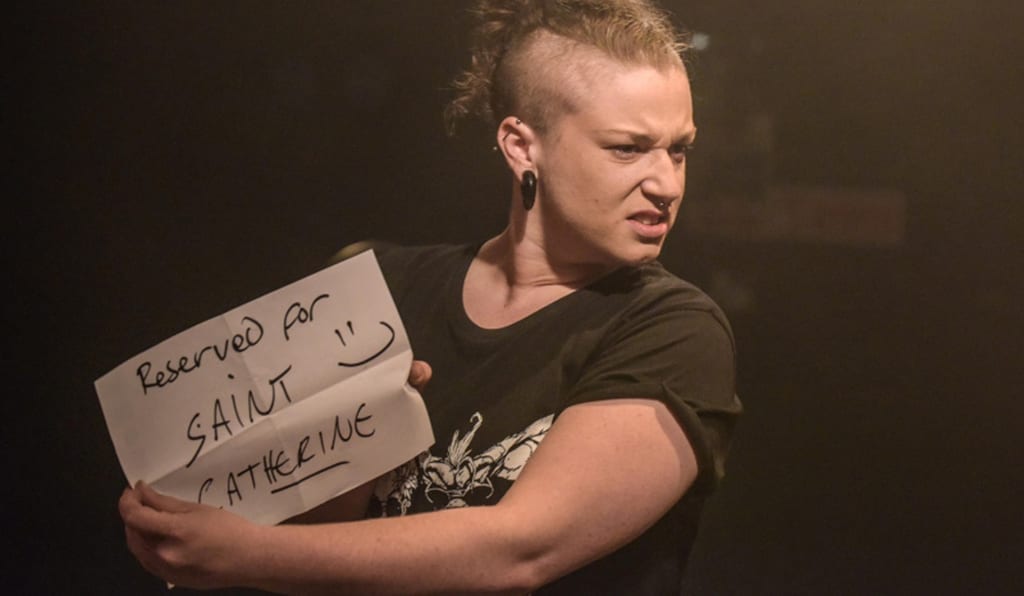When I first entered the Rep’s studio theatre for a performance of Milk Theatre’s ‘Joan’ I was struck by how differently the space was configured. Typically, the Door is an end-on theatre, with the audience sat on bleachers reminiscent of something out of an American high-school movie. Not so here. For ‘Joan’, the bleachers have been removed, and instead the audience are sat in-the-round. The seating is unreserved, which meant I watched the action from a high-stool, looking over the action as if it were a fight in a particularly rowdy bar. Some lucky members of the audience are sat at the very front at tables, which seem to have been taken directly from a pub.
With its merge of spoken-word poetry and cabaret, ‘Joan’ does have an air of a speakeasy about it. A fiercely intimidate performance, the reconfigured space allowed the captivated audience to see every tear and every wink Parkinson’s face produced over the course of the performance.
The set is simple, arguably the most noticeable feature of which is the audience itself. Besides four mirrors and four wooden crates, the in-the-round staging means it is impossible to watch Parkinson without having the audience in the background. This is both a good and bad thing. It lends an air of intimacy to the piece, and the beautiful scene in which Joan of Arc describes her relationship with her father – who loves her despite her haircut and funny clothes – takes on the air of an autobiographical confession, and it is hard not to be moved when Parkinson, teary eyed, locks eyes with you. She seems to be begging for answers to questions only she knows. But the presence of the audience also means that when the narrative sags towards the end, including a somewhat cliché song about falling in love, the audience become more interesting than what is happening on stage.
The piece is at its best when the lines between audience and performer become blurred, as when the audience are conducted like an orchestra to recreate the Battle of Orléans. Split into four sections, the audience become the whirring of arrows, the drums of war, the whinnying of horses and a heavenly choir. It is funny! Parkinson acknowledges that it’s a little bit naff, which only adds to the fun of it. As someone who is reluctant to engage with any form of audience-participation, even I enjoyed these sequences.
But it seems as Skillbeck’s piece is not entirely sure what it wants to be. The cabaret songs (Parkinson is also drag-king LoUis CYfer when she is not touring in ‘Joan’) were at odds with the seriousness of Joan’s trial and eventual execution. Having a chair reserved for Saint Catherine was a nice touch, though the tragedy of Joan’s situation is seemingly forgotten. Joan, whilst having divine hallucinations, saw her own mother raped and killed, though this is never particularly dwelled upon, and before the audience can reflect on the horror of what Joan has witnessed Parkinson has become the Dauphin Charles, donning a sequined cap and jacket to perform a rowdy, trashy anthem to gender and sexual liberation.
‘Joan’ is, however, an important show, exploring one woman’s crisis between her faith and who she truly wants to be. The audience, the majority of whom were young teenagers, adored the piece – and Parkinson certainly knew it. A sly wink here, a nudge there, and their seeing beaming faces during the curtain-call certainly made up for the shortcomings of the piece.

